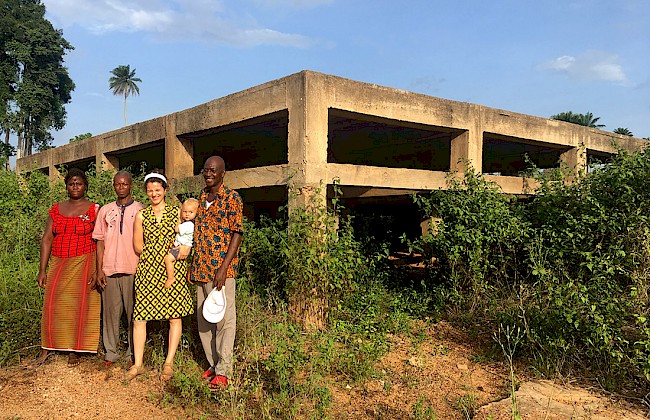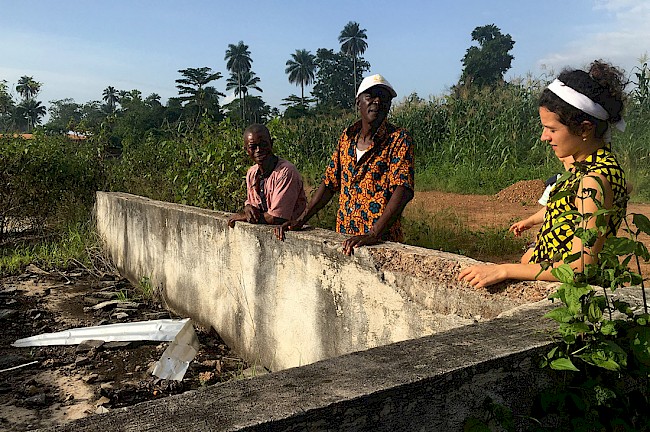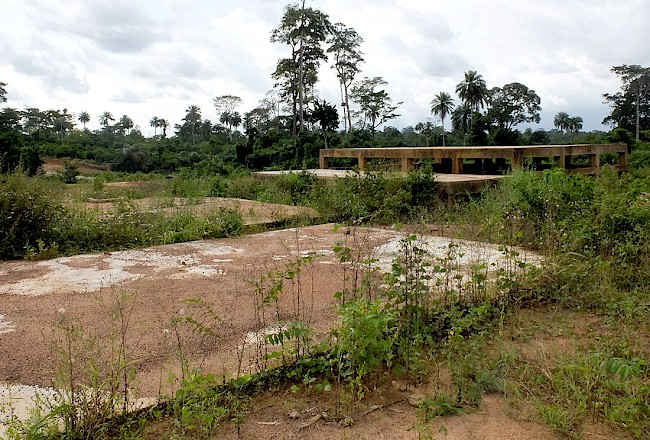Beneath Ebola ruins
The enduring temporariness of the 2014–2016 outbreak response in Guinea
—
Ebola epidemics have become a recurring scourge in the Democratic Republic of the Congo, which is currently grappling with its tenth outbreak since 1976. There is still little known about the ecological dynamics leading up to an outbreak and those acting between outbreaks. After an Ebola epidemic is declared ‘over’, local populations also look for answers to the problematic question: has the virus truly disappeared from their midst? Something material seems to leave outbreaks unresolved, something that detracts from a certain sense of closure. They persist beyond epidemic times, for example, in the traces of ruined treatment centres. Can Ebola ever be over?
During Ebola outbreaks, treatment centres are swiftly set up by humanitarian actors to isolate and manage cases. These structures and their equipment are not intended to outlast epidemics. In the aftermath, they are dismantled or largely abandoned, and many undergo ruination by humans and environmental elements.
Although emergency interventions approach the disease as a temporary phenomenon, Ebola outbreaks live on in rubble and memories. One might think that these remains would be perceived as infectious, the virus somehow seeping into the landscape. But their enduring temporariness does not seem to alert locals to the uncertain vanishing of the virus. Instead, they consecrate a temporal regime that is characteristic of African global health: the continuous deferral of lasting investment in health infrastructures.
June 2019
Alain had been a guard at an Ebola treatment centre that was assembled in 2014 in southeastern Guinea, where I had also worked as an anthropology graduate student. I have returned to the site a few times to explore the remains of the epidemic and understand how they influence local futures. Alain offers to walk me to a vast expanse that had been flattened for the building that was erected near his village. A small delegation of villagers follows us (image 1). Seventeen locals had been contracted by a nongovernmental organization (NGO) to work as guards, but, in reality, the entire village youth had turned up daily to be hired as labourers.
 1. Alain, the communal secretary, a neighbour, my child, and me in front of the former chlorine reservoir. Forest Guinea, 2019. Photo by Manuel Raab.
1. Alain, the communal secretary, a neighbour, my child, and me in front of the former chlorine reservoir. Forest Guinea, 2019. Photo by Manuel Raab.
The prefabricated lab, tarpaulin tents, and plastic mesh have been removed by the NGO that managed the structure. A skeleton of concrete slabs remains, overtaken by weeds (image 2). Alain steps between and across the former ‘red zone’, which hosted patients and whose access was restricted to care workers. ‘Here was the health promoters’ tent; here the fuel; here the doctors held their meetings; chlorine was stored in the “castle”’, he says. There is the area that had been cleared for planes, but none ever landed. We walk to what looks like a coffee plantation. I scarcely recognize the cemetery, where the wooden grave markers have been replaced by permanent plates (image 3).
Returning to the site, my gaze is not so much caught by what remains of the Ebola response as by what the remains are carved out of: the green frame of Guinea’s tropical forest. Newspaper photos about African Ebola outbreaks, whether in Guinea or the DRC, usually show both tents and palm trees, visually suggesting that the African ecology is a thriving environment for the Ebola virus, and that the fatal disease can be hermetically contained within a scaffolding of tarpaulin and plastic. But after the outbreak, once the plastic is removed, residues of the outbreak do not so much emerge from the landscape, as merge with it and are engulfed by it. It seems as if the dismantling of the humanitarian infrastructure could have liberated the virus into Guinea’s lush vegetation. I ask my former colleagues whether people are afraid of going to what they call the ‘cité’.
Assuredly, no one comes to tend to the site. People feared treading its soil for some time after the NGO’s departure. They were discouraged from digging there for their cultivations, they say, for they could unearth bones or be contaminated. Does Ebola still haunt former treatment sites as a dormant lethal force? Quite the opposite, it seems, as three years later these apprehensions are nearly gone (image 4). Coffee and corn have been successively cultivated on the site of the former centre. Jerrycans and sheet metal were also salvaged and brought to the village, ‘no matter whether they had virus in them’, the communal secretary says, laughing. The villagers were only temporarily concerned by a potential infection of their land, through the virus or the technologies that smothered it.
 4. The communal secretary elucidates the function of each concrete structure. Forest Guinea, 2019. Photo by Manuel Raab.
4. The communal secretary elucidates the function of each concrete structure. Forest Guinea, 2019. Photo by Manuel Raab.If there ever were doubts about whether the virus had disappeared, they do not so much signal failure to grasp epidemiological reasoning as awareness of a temporal paradox: Ebola is gone but its traces have come to stay. Traces are absences made present; they ‘point out to the absence of their cause, but are at the same time positively present’ (Geissler et al. 2016, 16). Pictures of the outbreak’s remains redouble what Roland Barthes (1981, 76) sees as the temporality of photography – ‘that-has-been’ – testifying that something ‘has been here, and yet immediately separated; it has been absolutely, irrefutably present, and yet already deferred’.
Such mechanics of temporal estrangement are important during epidemics. In a sense, the Ebola outbreak never happened. It is what Carlo Caduff (2014) calls a ‘quasi-event’, in that it was always already treated by decision makers and the media as announcing the ‘next pandemic’, thus deferring the ‘real’ apocalypse to the future. Photographs taken on the site of a former treatment centre reveal something about this deferral: such contemporary global health structures have no future.
The villagers say that the city is planning a larger replacement for the decrepit regional hospital on the site of the former treatment centre. This is confirmed by health authorities, who add that funding for the new university hospital has been secured from an Indian institution. The inhabitants of Alain’s village were forbidden to build or plant anything on the twenty-seven hectares reserved for the future construction. The promise was made years ago, but as I return repeatedly for field visits, my camera fails to capture traces of the growing power of non-Western states in African public health. Instead, I meet former employees of the centre under the roof of a shed, where they drink palm wine daily. As we chat, they urge me to set up another project, an enterprise, anything. They say they would offer me land at any price, provided ‘our relations last’.
Some others speculate about an influx in visitors to the locality, so they build commercial premises for pharmacies on the other side of the road. They span their investment over years, so the constructions are already eroded by the weather, like ‘half-built ruins’ (Tousignant 2016). The juxtaposition of these concrete blocks with the slabs of the treatment centre, the new and the old, epitomizes the singular temporality of global health in Africa, whereby both past and future leave lasting ruins but no infrastructure of care.
There is a strand in the anthropology of global health that is interested in ruins of modernity, whether they are colonial maternity hospitals or postcolonial research stations for tropical diseases (Hunt 1999; Geissler et al. 2016). It sees in crumbling buildings the demise of a certain hopeful vision of the future, typical of the early years after independence. But Ebola remains are dissimilar: they are not material signs of the unkept promises of medical progress. They do not trigger nostalgia or regret about losing faith in modernity. Does this infrastructure testify to a regime of global health that stopped dreaming of grand improvements to health, leaving only an invisible menace in its wake?
Ebola does not seem to persist as an ecological threat to the populations. But the humanitarian intervention has an afterlife, one that shares the topography and matter of unmet infrastructural promises. Meanwhile, locals are prohibited from using their land as they wish, and are asked to wait for foreign actors to take careof their future. Their ‘capacity to aspire’ is impeded by the remains of enduring temporariness (Appadurai 2013).
These remarks prove timely as we witness, in the spring of 2019, another large-scale Ebola outbreak unfold in the Democratic Republic of the Congo. International institutions did not delay their intervention, but its spread has not been halted. The World Bank’s Pandemic Emergency Financing Facility was tapped into for the first time and partly paid for the rapid construction of a dozen Ebola treatment centres in the affected regions. Some were even pre-emptively set up in zones where the epidemic was predicted to expand, as recommended by preparedness experts after the West African outbreak.
Some treatment centres could well be perishable constructions that may save few lives and leave a lasting imprint of the virus’s passage through the landscape. Can we read opposition to this expected legacy in the recent attacks on Ebola treatment centres in the DRC? The media tends to portray them as a manifestation of cultural misunderstandings, distrust and anger about the indecent flows of money poured into the epidemic response (see, for example, Cascais 2019). But the reasons behind such acts may be locally contingent and also involve diffuse environmental worries. Single-use structures might be destroyed to prevent soil contamination by the virus or by the foreign technologies of biomedicine, which could render the land unusable for an indefinite period of time. Locals may be attempting to contain the open-endedness of the Ebola threat, to prevent it from durably and materially lodging in their midst. Thus a point may be made that the whole Ebola phenomenon, including its emergency structures, should remain more temporary than enduring.
About the author
Emmanuelle Roth is a PhD candidate in Social Anthropology at the University of Cambridge. She currently conducts fieldwork in Guinea on biosecuritization in the aftermath of the Ebola outbreak. She follows the work of viral surveillance and research on the ecology of emergent diseases conducted at interspecies interfaces and, more specifically, on the search for Ebola’s origins in Guinea. She is interested in the entanglement of epidemic epistemologies and the making of local futures.
References
Appadurai, Arjun. 2013. The Future as Cultural Fact: Essays on the Global Condition. London: Verso.
Barthes, Roland. 1981. Camera Lucida: Reflections on Photography. Translated by Richard Howard. New York: Hill and Wang.
Caduff, Carlo. 2014. ‘Pandemic Prophecy, or How to Have Faith in Reason’. Current Anthropology 55 (3): 296–315.
Cascais, Antonio. 2019. ‘Conflict, Superstition and Inadequate Funds Hinder Ebola Fight in DR Congo’. Deutsche Welle, 17 May. https://www.dw.com/en/conflict-superstition-and-inadequate-funds-hinder-ebola-fight-in-dr-congo/a-48779000-0.
Geissler, Paul Wenzel, Guillaume Lachenal, John Manton, and Noemi Tousignant, eds. 2016. Traces of the Future: An Archaeology of Medical Science in Africa. Bristol: Intellect Books.
Hunt, Nancy Rose. 1999. A Colonial Lexicon: Of Birth Ritual, Medicalization, and Mobility in the Congo. Durham, NC: Duke University Press.
Tousignant, Noemie. 2016. ‘Half-Built Ruins’. In Traces of the Future: An Archaeology of Medical Science in Africa, edited by Paul Wenzel Geissler, Guillaume Lachenal, John Manton, and Noemi Tousignant, 35–38. Bristol: Intellect Books.

